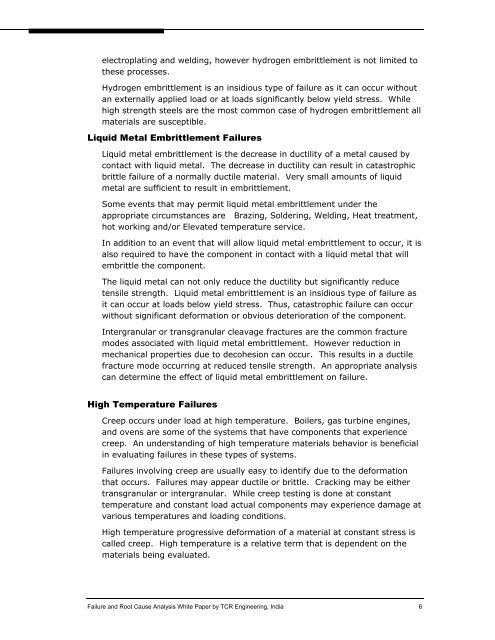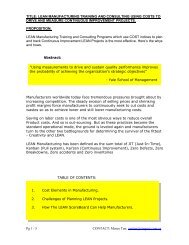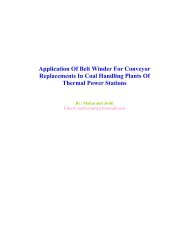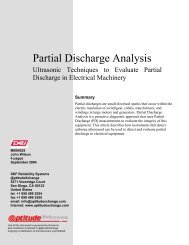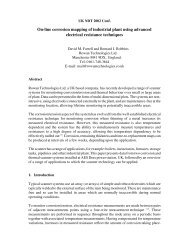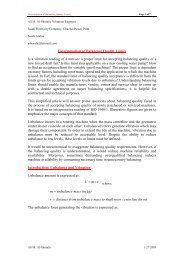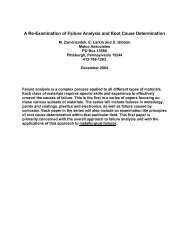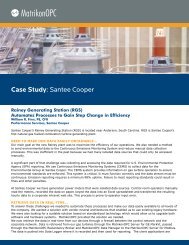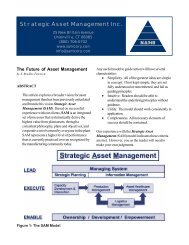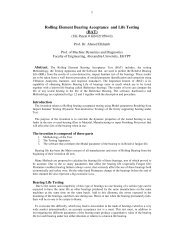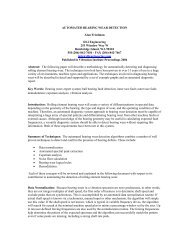Investigating Material and Component Failure - TCR Engineering ...
Investigating Material and Component Failure - TCR Engineering ...
Investigating Material and Component Failure - TCR Engineering ...
You also want an ePaper? Increase the reach of your titles
YUMPU automatically turns print PDFs into web optimized ePapers that Google loves.
electroplating <strong>and</strong> welding, however hydrogen embrittlement is not limited to<br />
these processes.<br />
Hydrogen embrittlement is an insidious type of failure as it can occur without<br />
an externally applied load or at loads significantly below yield stress. While<br />
high strength steels are the most common case of hydrogen embrittlement all<br />
materials are susceptible.<br />
Liquid Metal Embrittlement <strong>Failure</strong>s<br />
Liquid metal embrittlement is the decrease in ductility of a metal caused by<br />
contact with liquid metal. The decrease in ductility can result in catastrophic<br />
brittle failure of a normally ductile material. Very small amounts of liquid<br />
metal are sufficient to result in embrittlement.<br />
Some events that may permit liquid metal embrittlement under the<br />
appropriate circumstances are Brazing, Soldering, Welding, Heat treatment,<br />
hot working <strong>and</strong>/or Elevated temperature service.<br />
In addition to an event that will allow liquid metal embrittlement to occur, it is<br />
also required to have the component in contact with a liquid metal that will<br />
embrittle the component.<br />
The liquid metal can not only reduce the ductility but significantly reduce<br />
tensile strength. Liquid metal embrittlement is an insidious type of failure as<br />
it can occur at loads below yield stress. Thus, catastrophic failure can occur<br />
without significant deformation or obvious deterioration of the component.<br />
Intergranular or transgranular cleavage fractures are the common fracture<br />
modes associated with liquid metal embrittlement. However reduction in<br />
mechanical properties due to decohesion can occur. This results in a ductile<br />
fracture mode occurring at reduced tensile strength. An appropriate analysis<br />
can determine the effect of liquid metal embrittlement on failure.<br />
High Temperature <strong>Failure</strong>s<br />
Creep occurs under load at high temperature. Boilers, gas turbine engines,<br />
<strong>and</strong> ovens are some of the systems that have components that experience<br />
creep. An underst<strong>and</strong>ing of high temperature materials behavior is beneficial<br />
in evaluating failures in these types of systems.<br />
<strong>Failure</strong>s involving creep are usually easy to identify due to the deformation<br />
that occurs. <strong>Failure</strong>s may appear ductile or brittle. Cracking may be either<br />
transgranular or intergranular. While creep testing is done at constant<br />
temperature <strong>and</strong> constant load actual components may experience damage at<br />
various temperatures <strong>and</strong> loading conditions.<br />
High temperature progressive deformation of a material at constant stress is<br />
called creep. High temperature is a relative term that is dependent on the<br />
materials being evaluated.<br />
<strong>Failure</strong> <strong>and</strong> Root Cause Analysis White Paper by <strong>TCR</strong> <strong>Engineering</strong>, India 6


